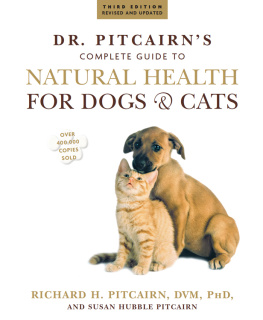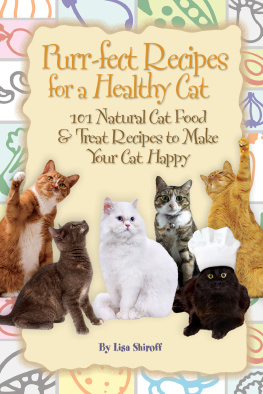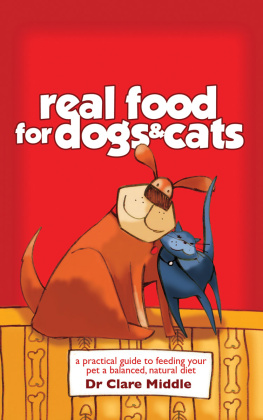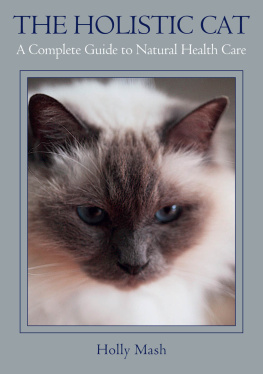Notice
This book is meant to supplement the advice and guidance of your veterinarian. No two medical conditions are the same. Moreover, we cannot be responsible for unsupervised treatments administered at home. Therefore, we urge you to seek out the best medical resources available to help you make informed decisions on pet care. Mention of specific companies, organizations, or authorities in this book does not imply endorsement by the publisher, nor does mention of specific companies, organizations, or authorities imply that they endorse this book. Internet addresses and telephone numbers given in this book were accurate at the time it went to press.
2005 by Richard H. Pitcairn and Susan H. Pitcairn
Cover photograph by Tsi Pictures/Getty Images
All rights reserved. No part of this publication may be reproduced or transmitted in any form or by any means, electronic or mechanical, including photocopying, recording, or any other information storage and retrieval system, without the written permission of the publisher.
The lists of natural cleaning methods that appear on are used with the permission of Creative Homeowner 1998.
Illustrations by Lizzie Harper
Book design by Tara Long
Library of Congress Cataloging-in-Publication Data
Pitcairn, Richard H.
Dr. Pitcairns complete guide to natural health for dogs & cats / Richard H. Pitcairn and Susan Hubble Pitcairn.3rd ed., rev. and updated.
p. cm.
Includes index.
ISBN-13 9781579549732 paperback
eISBN-13 9781594868597
ISBN-10 157954973X paperback
1. Dogs. 2. Cats. 3. DogsHealth. 4. CatsHealth. 5. DogsDiseases. 6. CatsDiseases.
I. Pitcairn, Susan Hubble. II. Title.
SF427.P63 2005
636.7'089dc22 2005013905

We inspire and enable people to improve their lives and the world around them
For more of our products visit rodalestore.com
CONTENTS
Anemia
FOREWORD
I first heard of Richard Pitcairn twenty years ago. I had been practicing veterinary medicine six years and had developed confidence in my veterinary skillsat least I no longer felt that I was a new graduate with only book learning and limited experience. Alongside that confidence, however, I was beginning to see that my new skills often lacked answers for many of my patients illnesses. I could offer temporary relief, but little else for so many animals with skin disease and other chronic illnesses, who constituted a large portion of my patients.
I began to seek other healing methods and attended a conventional veterinary conference that offered a one-day overview of holistic medicine by Carvel Tiekert, the founder of the American Holistic Veterinary Medical Association. Dr. Tiekerts lecture covered many modalities, including acupuncture, nutrition, and homeopathy. After the presentation, I asked him where he recommended I begin my journey into holistic medicine. He spoke three words: Get Richards book. I pressed him a bit further, wondering about courses or other classes, but he merely reemphasized, Get Richards book!
I followed his advice and immediately, as I began perusing the book, I understood why he tendered such a simple recommendation. I found Dr. Pitcairns (and Susan Pitcairns) book chock full of advice ranging from nutrition to homeopathic and herbal recommendations for quite a range of common ailments in cats and dogs. Additionally, the Pitcairns offered advice on how lifestyle, emotional support, and toxins affected animal health. While I was not unaware of these factors, I had certainly not learned anything of significance in veterinary school about how central such conditions are in creating healthy animals. My copy quickly became dog-eared, as I referred as often to it as to my texts from veterinary school.
I also ordered several copies to sell in my veterinary hospital, as I believe my primary role as a doctor is to educate my clients in animal care. I feel that I have done my best when my clients no longer need to call me, and Dr. Pitcairns book helps me lessen my clients dependence upon me.
A few years later I studied homeopathy with Dr. Pitcairn, and I was immediately impressed with his dedication, his scholarship, and his concern regarding the inadequate education we had received in veterinary school on nutrition and other methods to improve animal health. I also understood why his book was so thorough, well rounded, and clear, as he brought the same qualities to his seminars.
When the second edition of the Pitcairns book came out, I again purchased a copy for myself as well as copies for my clients, though I had by then sold my veterinary hospital so I could focus on homeopathy, for I also developed (in part through Dr. Pitcairns teaching and friendship) a love of this unusual branch of medicine.
Now, as I read this third edition, coming twenty years after I first saw the book and twenty-three years after its initial publication, I continue to be impressed with both the evolution of many aspects of the book as well as with the fact that its core information remains as useful and accurate as when it was first written. Additionally, this new edition has the benefit of those extra two and a half decades of Dr. Pitcairns experience. I especially value the updates and continual emphasis upon nutrition and lifestyle, factors that I also see as paramount in healing. I see in my own practice that feeding animals well and maintaining a healthy, stress-free home (emotionally healthy as well as toxin-free) remain the most important factors in keeping animals and people healthy. And as an ecologist, I deeply appreciate Dr. Pitcairns guidance in limiting our impact upon nature, offering less toxic options for parasite control and health care.
The treatment sections, of course, contain excellent guidance for what to do when an animal does become sick, with herbal and homeopathic suggestions. You will often be able to treat your animals at home, avoiding the stress of driving them to a veterinary clinic, hospitalization, injections, and the like, all of which can impede healing because of the stress. A rather unexpected (to me, anyway) benefit of holistic medicine is its gentle approach to health. For, while veterinarians all wish to help their patients, those patients tremble at the idea of visiting veterinarians. This was one of my biggest disappointments as a veterinarian. I wanted my patients to like me, but they all feared meuntil I began using non-painful, holistic methods like those in this book.
I still refer occasionally to the book for ideas when I need help with my patients, as there are a lot of gems within its pages. And it remains in my short list of recommended reading for my clients. I remain grateful for those like Dr. Tiekert and Dr. Pitcairn, who have guided so many veterinarians and non-veterinarians toward a better understanding of how to heal those animals with whom we share our lives. I believe you will feel the same once you spend a little time with Dr. Pitcairns Complete Guide to Natural Health for Dogs and Cats.
Your animal companions will be grateful as well, not only for helping them stay healthier, but also, more importantly, for keeping them at home, out of those dreaded veterinary hospitals!












